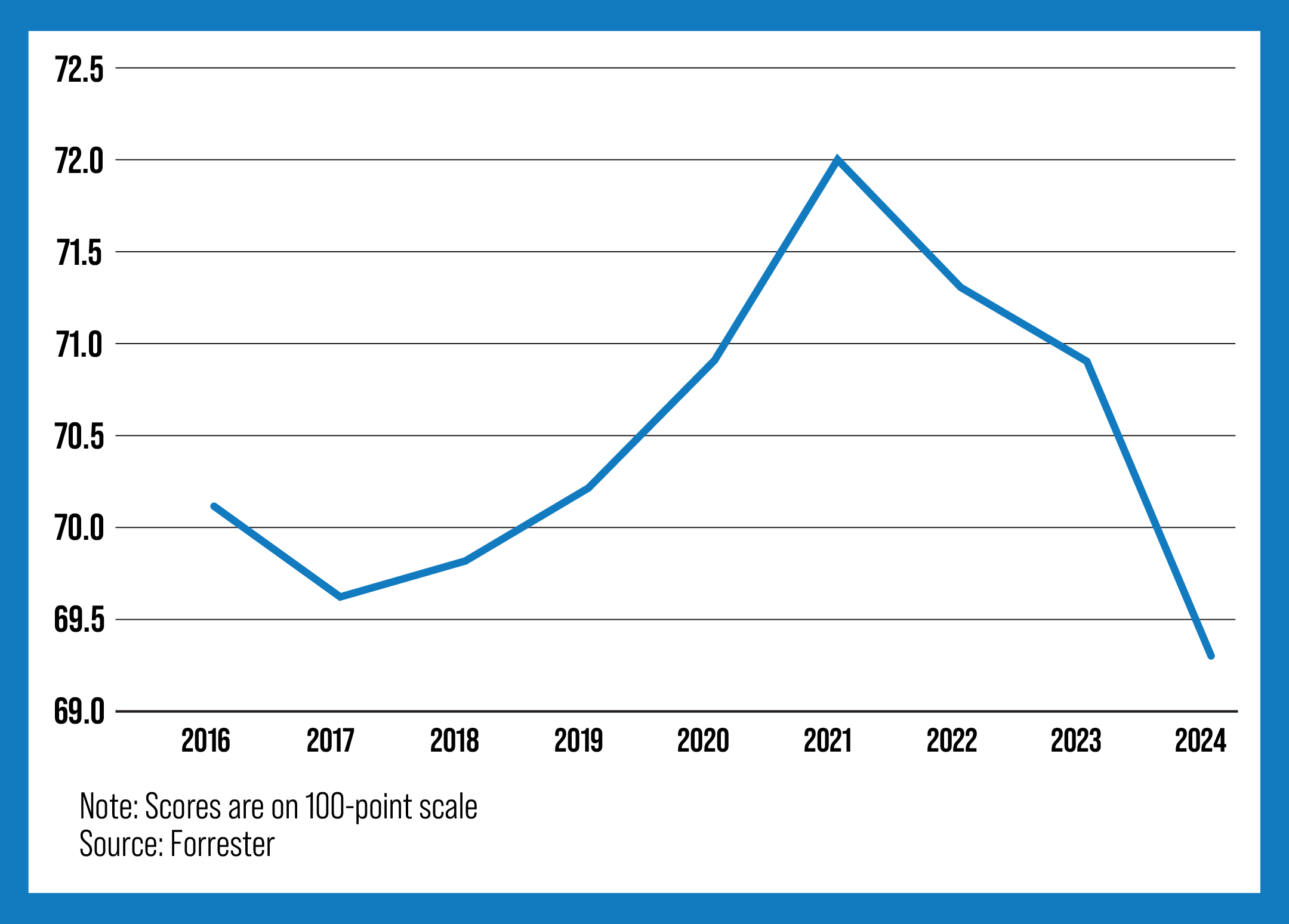Customer Experience Drives Customer Value
In today’s competitive market, customer experience is a critical driver of customer satisfaction. Therefore, companies that excel in delivering positive experiences are more likely to retain customers, increase profitability, and enhance brand reputation. In contrast, poor customer experiences can lead to customer churn, negative word-of-mouth, and lost revenue. Yet, many companies today struggle to provide excellent customer experience.
The Decline of Customer Experience
Since 2016, Forrester has surveyed nearly 100,000 consumers across 223 brands. The trend is shown below (reproduced from the Wall Street Journal, 2024). According to Forrester’s 2024 CX Index, the average customer experience score in the U.S. has decreased to 69.3 out of 100, its lowest since 2016.
Figure: Customer Experience Scores (2016-24)

Many recent examples, within the U.S. and worldwide, underscore this declining trend in customer experience.
- CenterPoint Energy: Hurricane Beryl knocked out power for more than 2.2 million of CenterPoint’s 2.8 million Houston-area customers, some for over a week. CenterPoint Energy responded with inaccurate updates, delayed service restoration, with many customers unable to find out about their status. Customer frustration has caused people to seek the CEO’s resignation.
- Australia: Australains spent nearly 100 million hours on hold during a 12-month period in 2023. Specifically, 13.3 million Australians tried to resolve issues with each customer speding 7.2 hours on hold trying to contact customer service representatives, and waiting more than a week (7.3 days) for issue resolution.
- AirAsia: A Malaysian airline has been losing customer trust due to eroding customer service. Customers report “long waiting times on the phone, unresponsive email communications, and inefficient handling of complaints through social media platforms.”
Customer-focused companies need to understand the reasons driving this downward trend in customer experience. There are two main reasons for the declining customer experience scores—underinvestment in customer experience and missteps with AI and technology.
Profits Over Customer
Many companies, often driven by a focus on short-term profitability, are hesitant to invest the necessary resources in customer experience.
A Harvard Business Review article cites data from a large telecommunications company that revealed customers who rated their experience as “best” were worth 140% more in revenue than those who rated their experience as “worst.” Other industries that underinvest in customer experience and satisfaction include airlines, banking, healthcare and utilities.
Forrester’s 2023 CX Index report found that industries which are traditionally slow to invest in customer experience improvements, consistently score lower in customer experience. This underinvestment harms customer satisfaction and loyalty affecting a company’s bottom line.
Missteps with AI and Technology
Despite its potential to increase efficiency for companies, the misuse or overreliance on technology and AI has negatively impacted customer experience in several ways. A systematic review reveals why AI often struggles with customer experience:
- Lack of Personalization: While AI is often used to tailor customer interactions, it can fall short in capturing the nuanced needs of individuals leading to generic or irrelevant responses that frustrate customers.
- Inaccurate Responses: AI systems, particularly insufficiently trained chatbots, may provide incorrect, useless or incomplete information.
- Overreliance on Automation: Companies that rely too heavily on AI-driven systems may neglect the human element essential for resolving complex or sensitive customer issues. This result can be a cold, impersonal experience for customers.
- Difficulty in Escalation: AI systems sometimes make it difficult for customers to sufficiently explain the complexity of their situation and escalate their issues to a human representative. This creates delays in problem resolution.
- Lack of Empathy: AI lacks the ability to understand and respond to emotions as humans do. This often results in tone-deaf and impersonal responses.
- Data Privacy Concerns: The extensive data collection required for AI operations raises significant privacy concerns. Customers can rightly become mistrustful given the high frequency of data breaches.
Conclusion: The Path Forward
To reverse the decline in customer experience, companies need to prioritize investments and humanize the processes delivering customer experience. This includes ensuring that any technological innovations, such as AI-driven solutions, are thoroughly tested and genuinely add value for customers.
References:
- “Customer Experience Gets Worse Again” The Wall Street Journal, August 24, 2024. https://www.wsj.com/articles/customer-experience-gets-worse-again-23774dff?mod=cmo-today_more_article_pos18
- “Houston Legend Mattress Mack Has Had It With the City’s Big Utility,” The Wall Street Journal, August 27, 2024. https://www.wsj.com/us-news/houston-legend-mattress-mack-has-had-it-with-the-citys-big-utility-053b4eb2?mod=hp_featst_pos3
- “The The worst industries for customer service: Aussies spent nearly 100 million hours on hold in the past 12 months,” 9NEWS, January 20, 2023. https://www.9news.com.au/national/worst-customer-service-australians-waste-96-million-hours-on-hold/a527c59d-7f1e-4770-beaa-da31105235ea
- “How AirAsia’s Deteriorating Customer Service Makes People Trust Them Less Now,” 300th.com, June 11, 2023. https://threehundredth.com/how-airasias-deteriorating-customer-service-makes-people-trust-them-less-now/
- Kriss, Peter. “The Value of Customer Experience, Quantified.” Harvard Business Review, August 2014. https://hbr.org/2014/08/the-value-of-customer-experience-quantified
- Dooley, Roger. “Is Customer Experience In Decline?” Forbes, June 30, 2023. https://www.forbes.com/sites/rogerdooley/2023/06/30/is-customer-experience-in-decline/
- Mittal, Vikas, Kyuhong Han, and Shrihari Sridhar. “Customer Satisfaction, Loyalty Behaviors, and Firm Financial Performance: What 40 Years of Research Tells Us.” Marketing Letters 34, no. 2 (2023): 171-187. https://link.springer.com/article/10.1007/s11002-023-09589-w
- Nicolescu, Luminița, and Monica Teodora Tudorache. “Human-Computer Interaction in Customer Service: The Experience with AI Chatbots—A Systematic Literature Review.” Electronics 11, no. 10 (2022): 1579. https://www.mdpi.com/2079-9292/11/10/1579
